
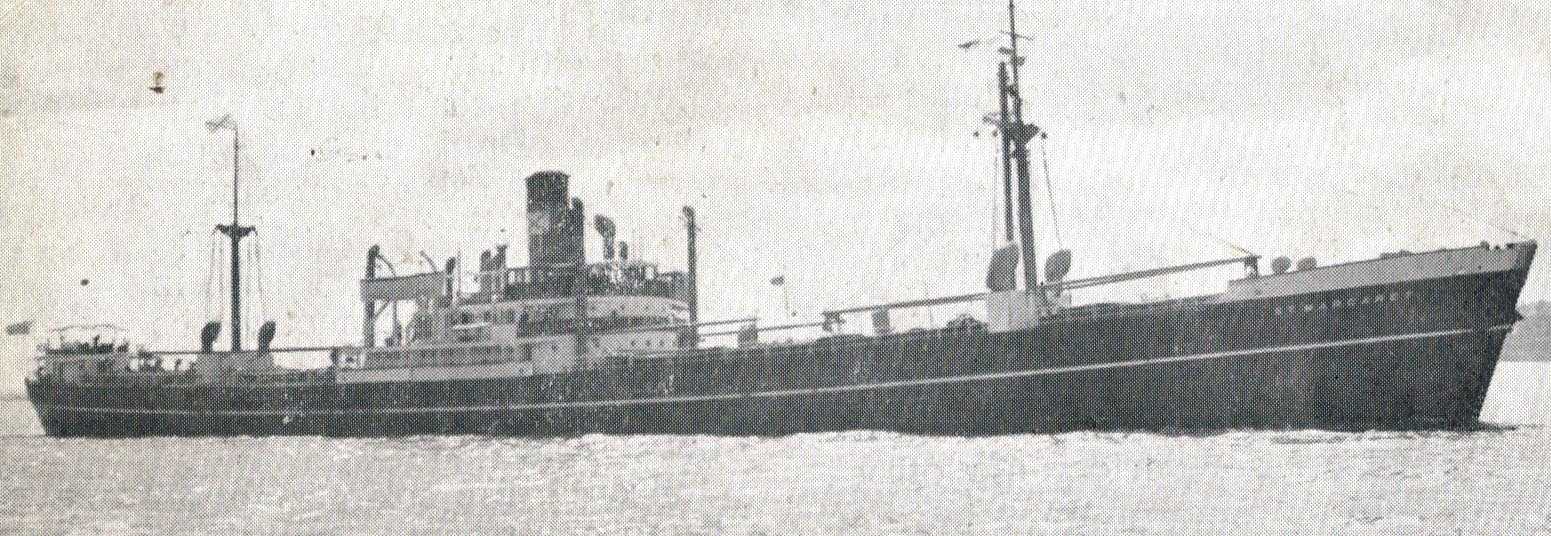
|
|
On the 2nd March 1943, the USS Hobson is recorded
as assisting in the rescue of survivors of the SS St Margaret. "Typical
of Hobson's versatile performance was her rescue of a group of
survivors from SS St. Margaret off Bermuda 2 March 1943."
- that's the whole reference. nothing else appears
on the net, - so what happened?
Judith Henry, of Carmarthenshire sent me some
papers. The ships Captain, David Sidney Davies, Judith's late uncle, was taken by the U Boat
that sank her, and incarcerated in a POW Camp in Germany. Judith has
kindly sent me a photo showing messages drawn on the camp hut rooftops
which I have copied below.
Also a copy of a Confidential letter entitled Shipping Casualties Section - Trade Division. Report
of an interview with the Chief Officer George Hamilton SS St Margaret 4312
GT. The account had been ascanned, using OCR, and some words came out
scrambled, I have altered this I have found.
|

|
|
This is an account of what happened, written by
Captain DS Davies himself, it appeared in the "Reef Knot" - the House
magazine of the Saint Line, published in 1948. The image of Capt Davies
and of the St Margaret above are also from the same publication:
February 2nd 1943, found the St Margaret, the
second of the three original vessels built for the South American Saint
Line, at Liverpool, ready to sail for South American ports. Consigned to
the Lamport & Holt Lines, the vessel was fully laden with a very superior
cargo consisting of machinery, textiles, whisky, stout, Yardley's products
etc; plus a consignment of military stores, destined to the Falkland
Islands, by transhipment at Montevideo. There were seven passengers,
including a German mother and daughter who had escaped from Germany just
before the war and now on their way to join the father in Buenos Aires.
The third lady was an ex hospital matron in charge of the hospital at
Port Stanley, Falklands Islands, when HMS Exeter of Graf spee fame arrived
after the Battle of the river Plate. She had been home to England buying
her trousseau and other things in preparation for her marriage. The
gentlemen passengers consisted of an estate manager from the Falklands,
two Belgians and a Hungarian Jew.
The vessel sailed on the a.m. tide on the 2nd
February. It was a typical winter morning, cold, windy and a threatening
sky. I well remember the Lock Gates man calling out "Good Luck" as we left
the locks. In accordance with our sealed orders, we proceeded to form up
with a local convoy, later joining the Belfast portion and finally, the
main Atlantic convoy from the Clyde. This convoy was bound for New York
and we were given our instructions to "proceed independently" at some
suitable date.
On the third morning after sailing, the weather
deteriorated rapidly, and from then onwards for almost a fortnight it was
a sequence of severe gales one after the other. Whilst normally, most of
the vessels in the convoy would be "hove to" for a considerable part of
the time, all were now making valiant efforts to remain with the convoy,
and thereby gain what protection there was. Two black balls by day and two
red lights by night, signifying vessel "not under command" were common in
all directions. Vessels in ballast were being blown almost on top of
others; laden vessels shipping heavy seas. All this, plus messages from
the Commodore, "Try and keep together. Enemy submarines in vicinity" did
not add to one's peace of mind. It almost made me wish I had stayed at
home and joined one of the guards Regiments or even the NFS. The St
Margaret made very heavy weather of it, being fully laden. The crews
quarters and passengers accommodation were flooded for days. The more
delicate sex had been granted the use of part of the Master's
accommodation, the others sleeping in the lounge.
At long last on Friday 19th February, we received
our orders to "proceed independently". We left the convoy at 9am on a
course which took us due south, through mid Atlantic. The weather had by
now eased up and, as we proceeded south, the was a marked daily
improvement. Our hopes were daily rising, as we got further from the
danger zone (we thought).
Saturday the 27th February, opened with prospects
of a good sub tropical day. At breakfast, passengers discussed how they
were going to take their trunks out on deck to dry the contents, how they
would be sunbathing etc. There was quite an atmosphere of cheerfulness,
and some relief on faces. The gunners had started cleaning their guns. We
had not heard or received any messages whatsoever of enemy activity for
several days. After breakfast the Chief Engineer was in my room and
we arranged to go around the decks and check up on what weather damage
there might be, but he was firstly going down to the Engine Room for a few
minutes.
Little did I think, when he left me, that it would be the last
time I would ever see him.
Whilst I was waiting for his return, I went to
look for the Chief Officer. I wanted all our boats which had been carried
in the Inboard position, placed outboard as the weather now warranted
this. I could see the Chief Officer on the after deck, port side, speaking
to someone, and I moved in his direction. Just as I approached him, a
terrific explosion took place, followed by huge columns of black smoke,
steam, water and oil combined, several hundred feet high, going up from
the midship part of the vessel. There was no mistaking, the vessel had
been torpedoed.
I made immediate attempts to reach the bridge,
but the rush of descending water, etc, cascading down, flooding the deck
to a depth to a depth of about eighteen inches was so strong that it made
progress very slow and difficult. Besides, I could not see more than a few
feet ahead of me. I groped my way along the ships rails and I remember the
impression came over me that the ship was sinking there and then. I
suppose if one had the time to think such an impression would not have
been a very pleasant one. I was anxious to get to the Bridge, to make sure
that the box containing the secret papers had been safely dealt with.
When I eventually
reached the Bridge and entered the Charthouse I found to my disgust and
annoyance that the box was still there. I carried it out and handed it to the
3rd Officer telling him to dump it. I will not repeat the other remark that was made. Whilst on
my way to the Bridge, I had called out Stand by the life-boats” and “See the
women in first.” From where I stood on the Bridge I could see the Starboard Big
Lifeboat in process of being loaded. The women were in. and the gunners were
also boarding it. The 2nd Officer was very ably conducting the operations. The
Port Big Lifeboat had been very badly damaged by the blast. I could see it would
not be much use, even if we could launch it at all. Because of this I called
out that as many as possible. without undue overloading, should go into the
Starboard Boat but that about a dozen men should stay behind on board to try and
get the other boats away. I then ordered the Starboard Boat to be lowered. I
also asked for a hurried Roll Call to be made.
This showed that there were four
missing, the Chief Engineer, a donkeyman, fireman and one passenger. I had by
that time verified that all communications between Bridge and Engineroom had
been completely destroyed. About then. I went down to my own quarters for a
moment having noticed that I had nit lifejacket. Inside my starboard door I
found the missing passenger, the Belgian. He was alright. but had been caught
without his lifebelt. He would not go down to his Cabin even when I assured hint
it would be safe if he hurried back. and he then proceeded to cry. It will sound
stupid. perhaps incredible. when I say that I could not help laughing. I asked
him “What the are you crying for?” I threw my life-jacket towards him and he
made record rime for the Starboard Boat and got in just as it was moving off. I
entered my bedroom for the last time, it was in a mess, the explosion having
occurred immediately underneath I picked up a Welsh Bible from the debris.
placed it inside my shirt, I had no coat on, and returned to the deck. The
reader will realize that since the explosion until now was only a matter of
minutes.
The vessel was
still on an even keel and there appeared no immediate danger of her sinking It
was certain that should she hold her own for very many minutes, a second torpedo
would strike. There was now on board, besides myself, the Chief Officer (whom I
thought had gone in the starboard boat), 3rd Officer, who worked very
bravely indeed, four sailors, the 2nd Cook, another very brave worker, and one
or two firemen. In fact, all these men were extremely cool and were ready to do
anything asked of them. As the Chief Officer was not very well I hailed the
Starboard Lifeboat to come under stern and he slid down a rope and took his
place in the boat. The next boat to get away was the small Starboard Boat, two
men were in this and were standing by “ ready to pick up the remainder should
anything happen. We still had to try and break the Belgian’s record for it. We
then tried the Port Small Boat, but this capsized and was subsequently left.
I asked the 3rd
Officer to try and get the Port Big Boat away, it would not last long I knew,
but we might be able to transfer the provisions and be glad of them at a future
date. Whilst this was being done I left the party with the view to having a look
around for the missing men. I first entered the Engineers alleyway. On looking
into the Engine Room I saw that it was completely flooded, right up to sea
level. There was much floating debris and I looked closely for any of the
missing men that might be floating around, injured. I then went along to the
Chief Engineer’s room, it was in a shambles, but no signs of life at all. I
called out several times, but all to no avail. I then walked aft, and entered
every one of the rooms calling, but there was no response.
On going forward
again. I noticed the ensign attached to the gaff halyards, lying at the heel of
the mainmast. It struck me that the “St. Margaret” should go down with her flag
flying so I hoisted the flag but when about two-thirds up it jammed and I had to
secure it in that position. I could see that the 3rd Officer and his gallant
helpers had succeeded in getting the Port Lifeboat out, and it was hanging about
half way down. They were calling on me to hurry as there would be another
torpedo soon. I once again entered the Engineer’s alleyway, went into the
Chief’s room and shifted some of the debris in case the Chief, who was a very
good friend of mine, might be underneath. It was all in vain. I at last had to
decide there was nothing more I could do. so I made for the ship’s side, the
lifeboat was now in the water and I slid down a lifeline and got into it. It was
with a very deep feeling of regret and almost guilt, that I left the “St.
Margaret.” The impression came over me that I was deserting her in her time of
trial. She was still upright and in an even keel and to me appeared very proud
and defiant, although mortally injured, and that it was only a matter of moments
before the enemy would strike again. As we pulled away I asked my comrades in
the boat to bare their heads whilst I committed our unfortunate shipmates. whom
we were leaving behind, to God’s care and mercy.
We pulled away in the direction of the other boat. We were
actually sitting in the water and it was touch and go whether we would make it
before the boat got full. When we were about two hundred yards or so away and
approaching the other boat, the second torpedo struck the vessel, also on the
Port Side. She soon commenced to list to port, then go down by the head, and in
a matter of minutes slid almost gracefully under. As she disappeared, I again
asked all in the two boats to bare their heads whilst I committed our lost
shipmates to God’s care and mercy, and asked for his care and guidance for the
remainder of us in the lifeboats. I should have said that on approaching the
other boats, we had to abandon the boat we were in as it was completely swamped.
I entered the Starboard Lifeboat. Soon after the old “St. Margaret" had
completely disappeared, a periscope was observed and a submarine surfaced and
made for the boats. When a short distance away, the Commander started howling at
us to come alongside. I say “howling” as that is the only way to describe it. He
was exactly as if mad. As we got nearer, I observed that we were covered by many
guns of different calibre and wondered what was going to happen next. The first
to be called to board the Submarine was the 3rd Officer, he wore a badged cap.
After asking some questions, the Commander asked for the Captain. I stood up and
was ordered to board the submarine. The Commander spoke reasonably good English
and had by now calmed down a little. He apologized for having to leave the
ladies in the boats, and said that I would be going with him to Germany. He
said, “Meeting you like this would be very romantic, if it was not for the
circumstances.” Thus commenced a journey on board what I was later to find out
was the Deutsch Unterseeboot U66. under the command of Captain Markworth, but
that is another story.
(Thanks to Tricia, for this information).
|
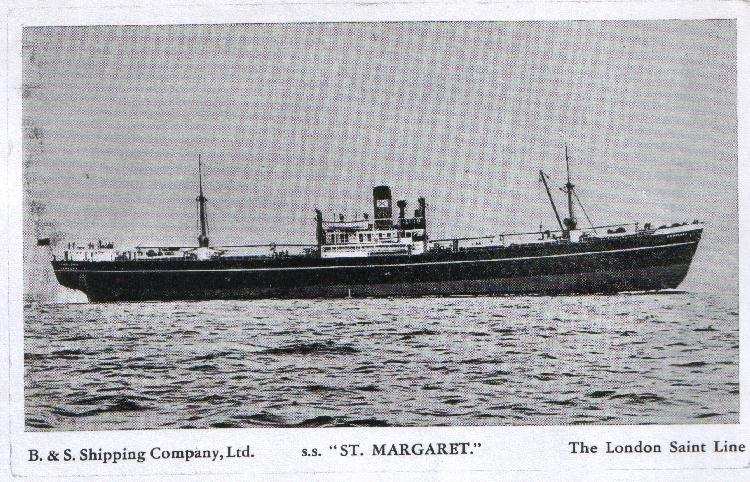
This is a scan of a photocopy, hence poor
quality
|
She sailed from Liverpool on February 2nd 1943
with convoy ON165, the convoy proceeded without incident (See (1) below) and dispersed on
19th February 1943 to sail independently. Here is the transcript of
the letter. I tried to scan it but microsoft word scanner does not like
WW2 typed paper!
|
|
Confidential DV
T.D. /139/1757
Shipping Casualties Section
- Trade Division
Report of an Interview with
the Chief Officer - George Hamilton
SS St Margaret - 4312 GT
Convoy ex ON 165
Sunk by two torpedoes from
U boat, 27th February 1943
All Times are ATS
(+ 3 hours 16 minutes GMT)
Chief Officer Hamilton
We were bound from Liverpool to
the River Plate with 6000 tons general cargo, armed with 1 x 4"; 1 x 12
pdr; 2 Oerlikons; 2 twin Marlin, 4 PAC Rockets and Kites. Our crew
numbered 43, including 5 Naval gunners, and we carried 7 passengers. Of
our total personnel, two were injured and four are missing. We carried
approximately ninety bags ordinary mail stowed in no 5 'tween deck; these
went down with the ship, and there is no chance of compromise. We also had
on board one bag special mail, which was put in the Confidential Book Box,
and thrown overboard; again, there is no chance of compromise. The
confidential Books and Wireless Codes were thrown overboard in weighted
boxes. Degaussing was off.
2. We left Liverpool at 0800 hrs
on February 2nd in convoy ON 165 and proceeded without incident until
Friday 19th February when the convoy dispersed, and we proceeded
independently. On 25th February a message was received reporting a
submarine operating in the area, approximately 345 miles SE of our
position. At 2100 on the 26th, a further message was received, but owing
to some misunderstanding in was not deciphered until the middle of the
watch, when it was found to read "if not south of position ....... alter
course immediately, and make for St Thomas. If south of this position,
ignore this message". When this message was deciphered, 0420 on 27th
February, we were making for Pernambuco to refuel, and we had insufficient
fuel to reach St Thomas. The Captain therefore decided to carry on the
course of 180 degrees to make Pernambuco.
3. At 0942 on 27th February 1943
when in position 27 38N, 43 23W steering 180 degrees (true) at a speed of
9 and one half knots, we were struck by a torpedo. There was an east wind,
Force 3, moderate sea with a heavy SE swell. The weather was cloudy, fine
and clear, with good visibility.
4. One of the apprentices saw the
torpedo break surface, as it was approximately six points from the box,
but thought it was a porpoise. It struck on the port side in the engine
room, with a very violent explosion, and a flash. A tremendous column of
water was thrown up, flooding the after deck. The engine room flooded to
the cylinder tops immediately, and the engines stopped. The main wireless
was completely destroyed. The deck did not not appeared to be damaged, but
the two ports boats, which were swung invoard at the time, were damaged.
The ship settled on an even keel, but did not list. The Captain ordered
"abandon ship" and No 3 boat got away in four minutes with 25 people,
including all the passengers. The No 1 lifeboat, which was cracked and
leaking badly, was lowered with seven or eight of the crew in it. Both
port boats were lowered, but filled on becoming waterborne. No rafts, two
rafts having previously been washed away through stress of weather.
Everyone was clear of the ship by 1010. Our wireless operators sent out
distress signals for 15 minutes, using the emergency set, before
abandoning ship and although the emergency set radiated satisfactorily, no
answer was received. The boats wireless set was placed in No 3 lifeboat
with the receiving set.
5. No 3 boat was the only really
seaworthy lifeboat, and contained 25 people, the remaining survivors being
distributed between No 1 boat and two rafts. I transferred provisions and
water from the waterlogged No 4 boat to a raft then set it adrift. After
trying to effect temporary repairs to No 1 boat, we found it impossible to
stop the leak, owing to the planks being split in the bilge streak, so
after removing the provisions to the raft, this boat was also cast adrift.
6. At 1045, the vessel was struck
by a second torpedo on the port side, in No 3 hold. This was a very
violent explosion, which caused cascades of water to pour through the
ventilators, the ventilator covers being blown off. We did not see a flash
or flame. At the time the boats were about 2 cables away, and we watched
the ship sink at 1055, vertically, bow first, with her stern out of the
water.
7. Shortly after the ship sank,
the submarine surfaced and closed the lifeboat, which contained the
Captain, 2nd Officer, all the passengers and some of the crew. The Captain
and 2nd Officer were taken on board the submarine and questioned. After a
time. the 2nd Officer was sent back to the lifeboat, but the Captain was
kept on board the submarine as prisoner of war. The submarine then closed
my raft, and I was taken on board to be questioned. The Commander asked me
where we were from, and were bound, but I refused to give him our exact
destination, saying that we were bound from England to South America. All
the time that I was on board, I was covered by bren guns, and after the
Commander had finished questioning, one of his crew took a number of
photographs of me. I was then ordered back onto the raft.
8. The submarine was obviously a
German of about 500 tons, and of the U-33 class (type 9C U-66 - mk) It
looked quite new and I could see no signs of rust or seaweed. I noticed
one gun forward, and a small AA gun mounted on the conning tower. A
Swastika was painted on the conning tower with a wolf through it. The
commander was tall, lean, dressed in a rather shabby khaki uniform, and
wore a red beard. He seemed very fit. I noticed that he spoke poor
English. The crew all worse long khaki trousers, in an equally shabby
state of repair. The Commander took our boats wireless transmitting set
from the lifeboat, together with a few tins of provisions from my raft.
Whilst I was in the conning tower, a Lieutenant asked survivors on the
raft for some cigarettes, for which he gave them in exchange some
cigarettes of a very inferior quality, of German manufacture. The
submarine then steamed away on the surface.
9. After this, I transferred to
the lifeboat to take charge, taking the two rafts in tow. I set sail at
1400, and steered a SS Wly course for St Thomas, which was approximately
1230 miles away. The (here some words are
missing from the copy).....
each raft carried 10 gallons of
water. We had a supply of smoke floats, rockets, red flares; the lifeboats
had a red sail and there were yellow protection suits. There were now 26
in the lifeboat, ten on one raft, and nine on the other. I put
everyone on very short rations, in view of the distance from land, a
typical meal being 1 and one half ounces of water, 3 horlicks tablets and
2 spoonsful pemmican.
10. We sailed through the night,
making about 1 knot, but at 0300 on the 28th the tow rope parted, and the
rafts broke adrift. I waited until daybreak before connecting them up
again, owing to the heavy swell, as I wished to avoid damaging the boat,
the rudder having already been damaged by the raft, necessitating lashing
the gudgeons to the pintles. At 0530 I connected up again and set sail. I
realised that even given the most favourable conditions, it would take 50
days to reach land, so I suggested to the crew that the rafts be cast
adrift, and for the boat to carry on independently, as there would be a
better chance of being picked up. The crew did not favour this suggestion,
so I shelved it for the time being, and carried on as before. During the
course of the day, one of the rafts showed signs of breaking up, so it was
necessary to transfer the men from it into the lifeboat. After removing
the stores, I cast this raft adrift. There were then 35 in the boat, with
ten men on the remaining raft; the lifeboat was very overcrowded, and our
limbs soon became stiff, due to the cramped conditions. I feel very
strongly that the lifeboats have not sufficient space for the numbers of
persons allocated to them.
11. At 0500 on 1st March, some of
my crew reported having seen aircraft, and although I did not see anything
I fired three rockets, and used three smoke flares, and several red
flares. Of course, we received no response to these signals, and I
considered the plane existed only in the imagination of those who reported
having sighted it. The following morning at 0700, a single aircraft was
sighted a great distance away in the SE'ly quarter, followed 10
minutes later by a second plane. I again sent up several distress
signals but after being in sight for a quarter of an hour both planes
disappeared without seeing us.
12. Shortly afterwards, another
aircraft was seen in the NE'ly quarter and appeared to be closing us, so I
fired our remaining rockets, which succeeded in attracting the attention
of this aircraft, at a distance of at least 10 miles. The plane flew over
the boat and gave a recognition signal, at approximately 0745, then flew
away. I thought it would take some considerable time for a rescue craft to
reach us, but at 0900 several funnels and masts were sighted to the NE. I
now ordered the motor to be started, and lowered sails on the raft and
lifeboat. I had deliberately reserved the petrol for such a purpose. When
the ships came into full view we recognised them as United States
warships. I manoeuvred the lifeboat and raft to the lee side of the
American Destroyer Hobson, and at 1003 everyone was taken on board, after
having sailed only 65 miles in 4 days. We were rescued in position 27 17N,
44,34W. The lifeboat and raft were destroyed by gunfire.
13. The Hobson landed us at
Bermuda on Friday March 5th. The crew were put on board an HM Ship on
March 15th and were landed at Portsmouth on March 22nd.
This is followed by a footnote
added much later to the bottom of page 3:
Distribution
C in C Western Approaches
DPD (Cdr Dillon Robinson)
SBNO Western Atlantic
DID (Cdr R Lister Kaye)
IMNG
NID 1/PW
DTD
NID 3/PW
DTD (DEMS)
NID (Cdr Winn)
D A/SW
Lieut Kidd USN
DTSD
DNO (London)
DTMI (Lieut Read)
DNC (Bath)
DSD (Lieut Thomas)
Files
Saint Margaret 4312 tons.
This ship was sunk in position 27
38N 42.23W on 27th February 1943. She was sailing independently at the
time. The submarine involved was U-66, Kapt Lt Markworth. The log gives
the time of firing the torpedo as 1731. Log book also reports that they
took the Captain of the St Margaret aboard as a prisoner.
Markworth was eventually wounded
by aircraft attack when returning from a patrol. 3 crewmen were killed and
8 wounded. Date was August 3rd 1943. He did not go to sea again.
|
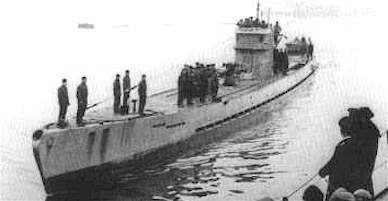
Type 9C, similar to U-66
|
|
Captain David Sidney Davies was held in the
prison camp shown below. On the rear of the original photograph he wrote:
"An aerial view of a Prisoner of War camp I
served in for a long period. This was taken a few days before our release
by the 2nd Armd Div. The Welsh & Scots Guards overran our camp at 1030 pm
27th April 1945. Noswaith byth i gofio
- (Welsh - An unforgettable night).
Note the signs painted on the roof POW Still Here. This was on account of
the bombing.
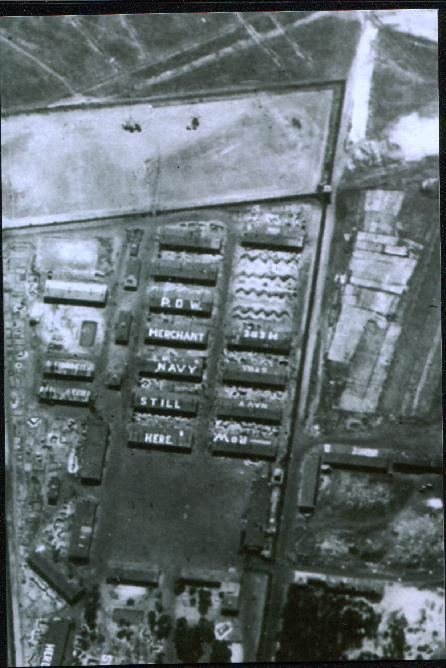
This is an enlargement of this image:
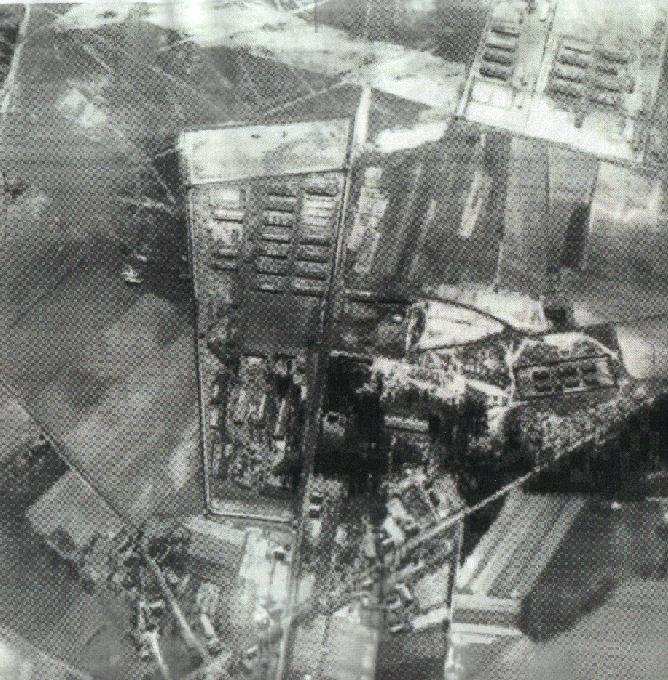
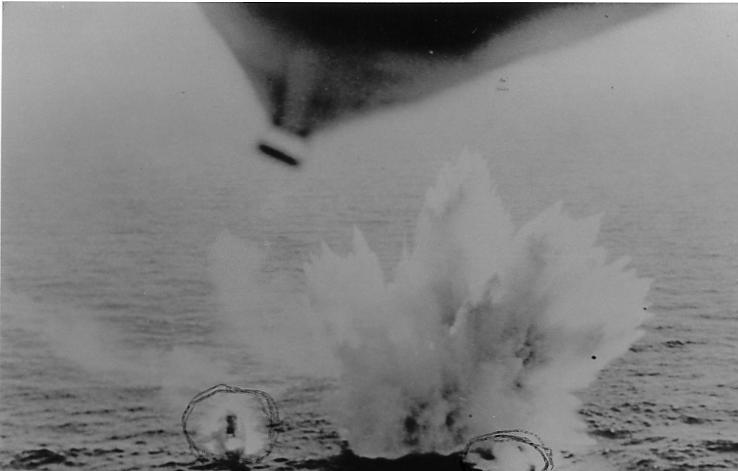
U66 (circled left) and U117 under attack August
3rd 1943
Aug 3, 1943 U-Boat 66 On Aug.
3rd a patrol team came upon U-66 at a point 475 miles WSW of Flores. The
Skipper, Capt./Lt F. Markworth was headed home after 14 weeks and 2 kills off
the east coast.
(One of which was, of course,
the St Margaret) Wildcats
strafed and wounded the deck officer and he ordered the boat to dive. The
captain came up the hatch and belayed the order and guns were manned.
Avenger
pilot, LT(JG) Richard Cromier, (USNR, VC-1) encouraged the boat to dive with two
depth charges followed by a FIDO which missed. Markworth surfaced again to fight
and was wounded so his next in command took the boat down. That night, he
reported to Adm. Doenitz and was told to make contact with U-Boat 117 for
refueling and assistance.
Aug 7, 1943 U-Boat
117 On Aug. 7th LT(JG) Sallenger, USNR, spotted two subs on the surface west of the Flores,
steaming parallel and about 500 yards apart. Without fighter cover he dove down
sun and made a straddle on U-66 and gave a few machine gun blasts on the
deck of the milch cow, U-117. After radioing the
Card for help he
stayed out of range for about 25 mins when three more planes arrived.
U-66
started to submerge, Sallenger dropped down again to drop a FIDO while flying
through a hail of fire from U-117. This U-boat had the new German
anti-aircraft guns and Sallenger reported that they were "rotten", all around
but no hits. Unable to submerge, U-117 was a sitting duck for the two
Avengers. The two assisting pilots were LT Charles Stapler and LT(JG) Junior
Forney. U-66 escaped again from the
Card group but was sunk by
another Task Group a few months later. Source:
http://www.navsource.org/archives/03/cve-11/011u.htm.
Fate of the U-66:
Sunk 6 May, 1944 west of the Cape Verde Islands, in position 17.17N, 32.29W, by
depth charges, ramming and gunfire from Avenger and Wildcat aircraft of the US
escort carrier USS Block Island and by the destroyer escort USS Buckley. 24 dead
and 36 survivors. Source:
http://uboat.net/boats/u66.htm
Its been a long long time since I had
anything to update on this page, but I got this email April 26th 2012.
My father served his
first year of apprenticeship aboard the SS St Margaret on her Maiden Voyage. He
later rejoined the ship about ?1940. His story goes on rejoining the ship, “The
St Margaret scarcely looked the same, peacetime colours had been black hull with
white stripes from stem to stern, white superstructure, red funnel with black
top and shining brass and gleaming varnished brightwork. Now she was wartime
grey from stem to stern, from truck to waterline. And the ugly shape of a four
inch gun was being bolted down on the steering house. The St Margaret had half
a dozen Canadian 0.300 Ross Rifles for, supposedly, sinking floating mines. The
gun was Japanese of 1912 vintage with separate ammunition.” Dad went into some
detail about how these guns worked, or didn’t work, as the case may be, but what
is interesting is that he started his four year apprenticeship on this ship and
it was on this same ship when his Indentures expired and was signed on the
ships articles as Cadet AB. My fathers name was Frederick Edgar Barley.
Thanks Regards Ellis Burgess.
|
| |
|